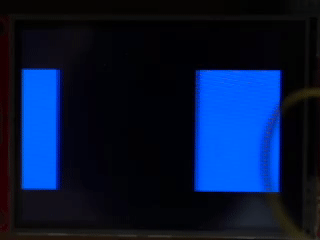hey @don41382 thanks for your feedback
It looks like the SPI bus isn't running at optimal speed.
Can you share the contents of setPanelConfiguration?
also some ideas:
- ILI9341 can do hardware scrolling which is smoother and faster, even if you're running the bus a 20MHz
- LGFX_Sprite has some scroll() methods, acts faster that redrawing the whole buffer

I am working on a scrolling effect on the ILI9341 screen.
In my example I am moving a blue rectangle from one side of the screen to the other. This creates (IMO) a vertical sync problem. I also tried using a buffer with DMA, which creates a similar result.
A ILI9341 library for Teensy boards implemented a vsync. Is that what I need to get it working. Maybe you have an idea.